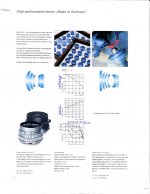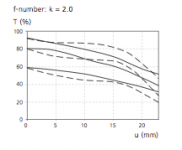Pistach said:
Ok I did not notice that they arrive to 100 mm. The half diagoinal is 21,6 and hence it is reasonable to arrive around 20. Actually this is the extreme corner, so that it is acceptable if the performance is still outstanding at 15-18. Moreover I am not able to find what aperture they refer to. If it is e.g. f8 it is not an outstanding performance anyway. I wish I had the graph for the Rokkor 40, one of my lens that are still undocumented. Please notice I do not mean reviews but just the MTF. As to reviews it is enough for me that HCB used it
The Rollei graph is for f/2.8 & is better than that for the 40/2 Summicron-C wide open, which on axis falls below 90 @ 10 lp/mm, is slightly above 70 at 20 lp/mm, & is at 50 for 40 lp/mm. The fall off in the field is very similar to the Rollei. The difference in favor of the Summicron-C is the lack of astigmatism displayed by the Sonnar. Optically, the Summicron-C should be pretty much the same as the Rokkor. These are classic lens designs from the early '70s. In these days of maximum sharpness, it's easy to forget that this was not always the case, but that lens designers were still able to obtain excellent & very appealing results. It's also unfortunate that Rollei chose to include only one MTF chart in tehir promotional material. It's impossible to judge a lens by the results at a single aperture. It's worth noting that Zeiss doesn't include 5 lp/mm in their MTF graphs as Leica does, so anyone who is used to looking at Leica graphs might be expecting a different look of the top line at first glance.
I don't have the ability to reproduce the Summicron-C MTF graphs here, but they can be found in the
Leica Pocket Book from Hove Collectors Books. Mine is the 7th edition.
Just to give a feel for the Summicron-C MTF graph, here are the results @ f/2 extending out from the axis at 0, 6, 12, & 18. Numbers are estimated from the graph.
5 lp/mm - 96, 90, 81, 70
10 lp/mm - 89, 79, 69, 60
20 lp/mm - 71, 60, 31, 49
40 lp/mm - 50, 27, 0, 30



